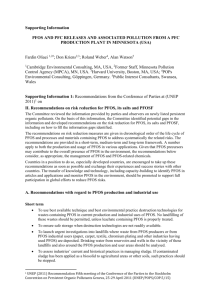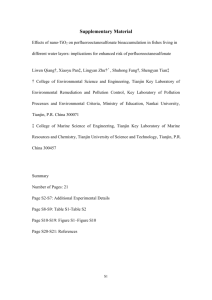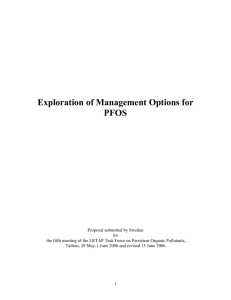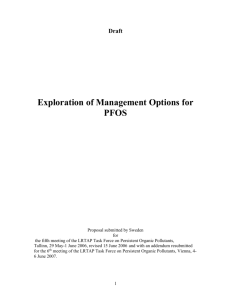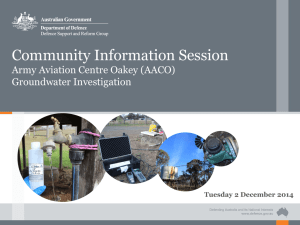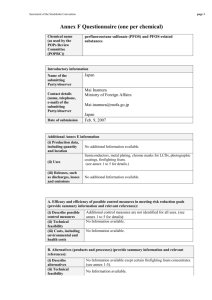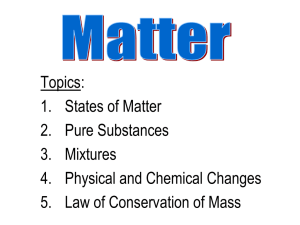draft paper for inc-7 - Stockholm Convention on Persistent Organic
advertisement
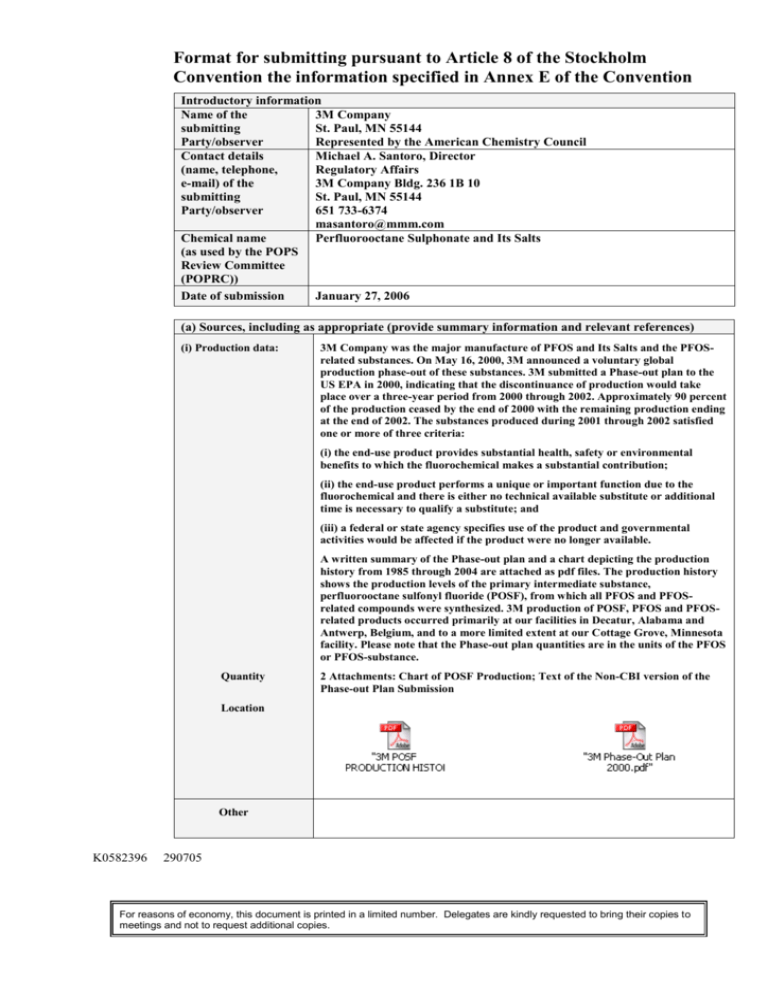
Format for submitting pursuant to Article 8 of the Stockholm Convention the information specified in Annex E of the Convention Introductory information Name of the 3M Company submitting St. Paul, MN 55144 Party/observer Represented by the American Chemistry Council Contact details Michael A. Santoro, Director (name, telephone, Regulatory Affairs e-mail) of the 3M Company Bldg. 236 1B 10 submitting St. Paul, MN 55144 Party/observer 651 733-6374 masantoro@mmm.com Chemical name Perfluorooctane Sulphonate and Its Salts (as used by the POPS Review Committee (POPRC)) Date of submission January 27, 2006 (a) Sources, including as appropriate (provide summary information and relevant references) (i) Production data: 3M Company was the major manufacture of PFOS and Its Salts and the PFOSrelated substances. On May 16, 2000, 3M announced a voluntary global production phase-out of these substances. 3M submitted a Phase-out plan to the US EPA in 2000, indicating that the discontinuance of production would take place over a three-year period from 2000 through 2002. Approximately 90 percent of the production ceased by the end of 2000 with the remaining production ending at the end of 2002. The substances produced during 2001 through 2002 satisfied one or more of three criteria: (i) the end-use product provides substantial health, safety or environmental benefits to which the fluorochemical makes a substantial contribution; (ii) the end-use product performs a unique or important function due to the fluorochemical and there is either no technical available substitute or additional time is necessary to qualify a substitute; and (iii) a federal or state agency specifies use of the product and governmental activities would be affected if the product were no longer available. A written summary of the Phase-out plan and a chart depicting the production history from 1985 through 2004 are attached as pdf files. The production history shows the production levels of the primary intermediate substance, perfluorooctane sulfonyl fluoride (POSF), from which all PFOS and PFOSrelated compounds were synthesized. 3M production of POSF, PFOS and PFOSrelated products occurred primarily at our facilities in Decatur, Alabama and Antwerp, Belgium, and to a more limited extent at our Cottage Grove, Minnesota facility. Please note that the Phase-out plan quantities are in the units of the PFOS or PFOS-substance. Quantity 2 Attachments: Chart of POSF Production; Text of the Non-CBI version of the Phase-out Plan Submission Location Other K0582396 290705 For reasons of economy, this document is printed in a limited number. Delegates are kindly requested to bring their copies to meetings and not to request additional copies. UNEP/POPS/POPRC.1/4 (ii) Uses The main uses for PFOS and PFOS-related substances were described in the Swedish Dossier. However, while 3M has discontinued production, as noted above, uses of these substances are continuing in certain critical applications, and manufacture of PFOS and PFOS-related substances – not by 3M but by other companies – is still occurring to support these uses. The supply of the products used in these critical applications could be from a number of sources: continuing manufacturing in Europe and Asia, inventory held by distributors or inventory held by OEM businesses and former customers of these substances. As to these critical applications, the U.S. EPA promulgated a Significant New Use Rule (SNUR) under Section 5 of the Toxic Substances Control Act (TSCA) following 3M’s voluntary production phase out. See 40 C.F.R. Part 721. The SNUR allows continued manufacture and import of PFOS and PFOS-related substances for use in the following critical applications: (i) "use as an antierosion additive" in aviation brake fluids; (ii) "use as a component of a photoresist substance"; (iii) "use in coatings for surface tension" to produce digital images; and (iv) "use as an intermediate only to produce other chemicals substances to be used solely for [these exempt] . . . uses . . . ." Due to the TSCA legal structure, the SNUR restricted forward-looking manufacture of PFOS and PFOS-related substances for use in production of new products following the 3M production phase-out. Hence, the SNUR did not address critical applications involving products no longer being produced by 3M, but that remain in inventory and available for use. One such critical application is fire-fighting foam. Relative to fire-fighting foam, 3M was a manufacturer of a product that contained PFOS as an ingredient. The substance functioned as a film-forming agent that permits the foam to spread quickly over the surface of a fire and thus allowing for the rapid extinguishing of the fire. There is an inventory of this product in a number of locations globally. As the review of PFOS proceeds to the Annex F process, it is important to note that at present fire-fighting foams containing PFOS or other perfluorinated compounds do perform very effectively in critical use scenarios. Use of the foams would likely be under extraordinary or emergency situations where life and property are at risk and would not be used in a routine, day-by-day manner. The recent draft EU Marketing Use Restriction now being considered in the Parliament r would permit the continued use of PFOS-based foams with derogation. This directive also would recognize -- in addition to the critical applications in the U.S. EPA SNUR -- mist suppressants for chromium plating and semiconductor anti-reflective coatings as critical applications for PFOS and PFOS-related substances. This proposed Directive is attached. (iii) Releases: Discharges Losses Emissions Other 2 Again, 3M has ceased production of PFOS and PFOS-related substances. Discharges, if any, from our manufacturing facilities would not be associated with ongoing production. UNEP/POPS/POPRC.1/4 (b) Hazard assessment for endpoints of concern, including consideration of toxicological interactions involving multiple chemicals (provide summary information and relevant references) Over the past years, 3M Company has carried out numerous human toxicological and ecotoxicological studies on PFOS and its salts and a few of the PFOS precursors. All of these studies are in the public record and available electronically in an EPA Docket AR 226. The information has also been converted to 7 CDs, which have been provided to a number of OECD country regulatory agencies. Many of these studies have been used to develop the OECD Hazard Assessment, the dossier prepared by Sweden and other assessments performed by OECD countries. In addition to the submissions to regulatory agencies, 3M and other others have published the results of these studies in peer-reviewed scientific journals. This bibliography is available if needed. 3 UNEP/POPS/POPRC.1/4 (c) Environmental fate (provide summary information and relevant references) Chemical/physical properties A summary of the physical chemical properties of PFOS has been provided in the Swedish Dossier. However, the properties of the other 96 substances have not generally been developed. Many of the 96 substances are longer chain polymeric structures that have very different environmental characteristics such as solubility, stability, ability to be absorbed or metabolized, etc. as compared to PFOS. Current information is not available to assess each of these substances under the Annex D criteria. Persistence The information provided for PFOS in the Swedish Dossier is accurate. However, there is inadequate data available on the persistence of the 96 substances. How are chemical/physical properties and persistence linked to environmental transport, transfer within and between environmental compartments, degradation and transformation to other chemicals? Monitoring data indicates that PFOS is found widespread in the environment. Since PFOS and its salts have a very low vapour pressure, it is unlikely that PFOS itself volatilized and was transported atmospherically. On a qualitative basis, it can be assumed that one or more volatile precursors were transported atmospherically followed by deposition, uptake and either degradation or metabolism by living organisms. However, since very little information is available on the physical chemical properties of the precursors, there is insufficient information to develop scientifically robust conclusions on these transport mechanisms. In addition, because of the physical chemical properties of PFOS and its unique behaviour in the environment and in biota, careful consideration should be given in the use of any classical modeling approach, which may produce overly conservative or inaccurate results. Bio-concentration or bioaccumulation factor, based on measured values (unless monitoring data are judged to meet this need) The information provided for PFOS in the Swedish Dossier and other data presented as part of the Annex D assessment at the POPRC meeting suggests that the BCF for PFOS is below 5000. As stated in the POPRC, other criteria within the bioaccumulation subsection of Annex D indicated that PFOS qualifies as sufficiently bioaccumulative. Current is not available on the bioconcentration or bioaccumulation characteristics of all the 96 substances. (d) Monitoring data (provide summary information and relevant references) The information provided to the public docket by 3M includes monitoring data, both of biota and aquatic samples of PFOS. Since this data is readily available and to a large degree used in the Annex D review, the data will not be provided here. However, additional monitoring data can be found in a number of posters presented at the Fluoros Conference held in Toronto, Canada in August 2005. We have provided a link to that website. Trend data are available in a SETAC Europe Abstract (attached) indicating that PFOS levels have decreased significantly in ringed seal livers collected from two locations in the Canadian Arctic. There are a number of researchers presently engaged in studying the temporal changes in the environmental concentrations of PFOS. Some of this research will be published this year, and thus it is recommended that the Review Committee assess this information as it becomes available. 2 Attachments: Link to Fluoros Conference website; Abstract of a SETAC Europe Paper http://www.chem.utoronto.ca/symposium/fluoros/contact.htm 4 UNEP/POPS/POPRC.1/4 (e) Exposure in local areas (provide summary information and relevant references) - general As noted in the previous sections, monitoring data has been collected and is in the public record. Much of this These data are from locations some distance from the known emission sources of PFOS and its salts or the PFOS-related substances, such as the manufacturing plants where these substances were produced or used. The submissions by 3M included monitoring data in US cities in which PFOS-related substances were used in the manufacture of articles of commerce. This data summarized in a Multi City studyshows the presence of PFOS in various environmental media at low concentrations. General population and occupational human exposure data have been provided in the public record. We are attaching two recent publications, one a longitudinal study of the levels of PFOS in blood of a group of individuals over a 27-year period of time that shows a levelling of concentrations in later years.. The other study is a medical monitoring study of occupationally exposed employees of 3M Company that shows no health related effects from the presence of PFOS at higher levels of exposure than found in the general population. Further, 3M Company has embarked on environmental investigations at the former manufacturing sites in the US (2 sites) and in Europe (1 site) to assess the presence and potential impacts of PFOS in and around those sites. The monitoring data and assessments will be placed in the public record during 2006. - as a result of long-range environmental transport - information regarding bioavailability While it is likely that long-range transport resulted in this widespread presence of PFOS, the mechanism of this transport is not scientifically understood. 5 UNEP/POPS/POPRC.1/4 (f) National and international risk evaluations, assessments or profiles and labelling information and hazard classifications, as available (provide summary information and relevant references) In 2003, 3M Company developed a risk characterization of PFOS and Its Salts, entitled “Environmental and Health Assessment Document (EHAD).” Hazard data from the EHAD was referenced in the Swedish Dossier. However, the EHAD used that hazard data and compared it with exposure information to create a risk characterization. Attached to this section is a copy of the Executive Summary of the EHAD, the Conclusion statement, and graphs showing the relationship between environmental monitoring data with Predicted No Effect Concentrations (PEC/PNEC). The conclusion of the EHAD is that no adverse effects would be expected from the low levels of PFOS found in humans or the environment. As 3M Company has discontinued production of PFOS and PFOS-related substances, and ongoing production in the US has come under regulatory controls, environmental concentrations would be expected to decline over time. Relative to governmental assessments, the UK Environmental Agency has developed a Risk Evaluation Report, using the EUSES model to predict environmental concentrations of PFOS, assuming that the production levels occurring in 2000 would continue into the future. As shown in Section (a) (1), production of these substances by 3M has ceased, and there is no indication that other companies are producing the phased-out products. There have been two formal critiques of this RER Report, one by the EU Scientific Committee on Health and the Environmental (SCHER) and one by Exponent, an international consulting firm retained by 3M to review the UK Assessment. In the SCHER Report it was noted that the assumptions made to assess risk were not substantiated. The conclusion of the Exponent Report states that “two independent lines of evidence indicate that there are not significant risks to wildlife populations from exposure to PFOS, and that the risks predicted in the RER for such groups is overstated.” 3 Attachments: 6 1. Executive Summary of EHAD Document (including the graphs of the PEC/PNEC Quotients and the Conclusion Statement 2. Executive Summary of Exponent Report 3. SCHER Report summary UNEP/POPS/POPRC.1/4 (g) Status of the chemical under international conventions 1. US EPA SNUR Rule – 2003 2. UK Risk Reduction Strategy 3. EU Marketing and Use Restriction proposal with Annex 4. LRTAP POPs Protocol activity ___________________________ 7


